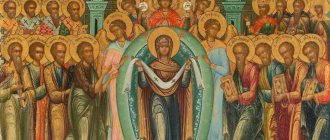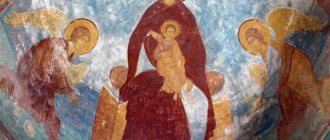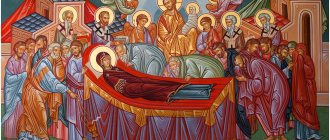| Position of the honorable robe of the Blessed Virgin Mary. Greek icon |
Position of the honorable Robe of the Blessed Virgin Mary in Blachernae
, holiday of the Orthodox Church Celebration of July 2
According to legend, the Robe of the Mother of God was found in Nazareth in 471 and transferred to the Blachernae Church in Constantinople. Subsequently, the omophorion of the Most Pure One and part of Her belt were also placed in the precious ark with the robe.
More than once, during enemy invasions, the Most Holy Theotokos saved the city, to which she bestowed Her sacred Robe. This happened during the siege of Constantinople by the Avars in 626, the Persians in 677, and the Arabs in 717.
In 860, the fleet of the Russian prince Askold devastated the shores of the Black Sea and Bosphorus and besieged the capital of Byzantium. Emperor Michael III prayed all night, prostrating himself on the stone slabs of the Blachernae Temple. Holy Patriarch Photius addressed the people with a sermon, calling on them to repent and in earnest prayer resort to the protection of the Most Holy Theotokos. After a nationwide prayer service, the robe of the Mother of God with the procession of the Cross was carried around the city walls, its edge was immersed in the waters of the Bosphorus, and then transferred to the Church of St. Sophia in the center of Constantinople. The Queen of Heaven pacified the belligerence of the Russians, and after some time, having concluded a truce, they began to retreat. The terms of the peace treaty included a provision on the baptism of Rus'. Soon Prince Askold himself was baptized with the name Nikolai, and many of his squad were also baptized.
Thus, the feast of the Placing of the Robe of the Most Holy Theotokos in Blachernae is the feast of the founding of the Russian Orthodox Metropolis in Kyiv.
| Position of the honorable robe of the Blessed Virgin Mary. Temple icon of the Borodavsky Robe Temple, 1485, Kirillo-Belozersky Museum. |
The veneration of the Feast of the Placing of the Robe has been known since ancient times in the Russian Church.
In honor of him, the holy noble prince Andrei Bogolyubsky erected a temple in Vladimir on the Golden Gate. At the end of the 14th century, part of the Robe of the Mother of God was transferred from Constantinople to Rus' by St. Dionysius, Archbishop of Suzdal. The Holy Robe of the Mother of God, which previously guarded Constantinople, later saved Moscow from the enemy.
In the summer of 1451, hordes of the Tatar prince Mazovsha approached the Russian capital. Saint Jonah, Metropolitan of All Rus', strengthened the defenders of the capital with incessant prayers. According to the chronicle, on the night of July 2, great confusion occurred in the Tatar camp, the enemies abandoned their stolen goods and hastily retreated in disarray.
Historical excursion[edit]
The Most Holy Theotokos was bequeathed by the Most Holy Theotokos before Her Dormition to two poor widows in Nazareth, who served Her and received benefits from Her. One of these widows wished that this blessed gift should always be inherited from one girl to another. Thus, for centuries, the sacred tunic was preserved with great reverence in the Holy Land. In the 5th century, two brothers, noble Greek nobles Galvius and Candide, went to worship holy places in Palestine. In Nazareth, they stopped for the night in the house of an elderly Jewish woman, where they saw a room with many burning candles, continuously burning incense and many sick people thirsting for healing. When asked what the reason for such veneration of this place was, they heard the following story: Here I keep the robe of the Most Pure Virgin Mary, who gave birth to Christ God. When She passed from earth to heaven, one of my ancestors, a widow, was present at Her burial; According to the will of the Most Pure Mother of God herself, that honorable robe was given to her; She, having received that robe, kept it with reverence all the days of her life; dying, she gave the robe for storage to one maiden from her family, commanding her with an oath to keep in purity for the honor of the Mother of God herself, not only that honest robe of the Most Holy Theotokos, but also her very virginity.
Having the opportunity to spend the night next to the shrine, the brothers measured the ark in which it was kept, and then in Jerusalem they ordered a copy of it to be made and a gold-woven cover for it. On the way back to Nazareth, they replaced the ark with the Robe and brought the relic to Constantinople. Saint Gennady, Patriarch of Constantinople, and Emperor Leo the Great (457–471), greeted the shrine with sacred trepidation and decided to place it in the best, most honorable place. In Blachernae, near the seashore, a new temple was erected in honor of the Mother of God. The temple was located close to the emperor's palace chambers: covered passages connected the temple and the palace. On July 2, 458, Patriarch Gennady with appropriate triumph transferred the sacred robe to the Blachernae temple. Subsequently, Her holy omophorion and part of Her belt were placed in the ark with the robe of the Mother of God.
According to the historian Nicephorus Callistus, who lived in the 6th century, “the robe of the Mother of God was preserved in this temple and is still preserved as protection for the city, providing various healings and defeating nature and time with its miracles.” It was in Constantinople that the first miracle from the tunic of the Most Pure Virgin was revealed.
In the spring of 626, a huge army of Persians and Khazars approached the capital. The Emperor of Byzantium, Heraclius, was not in the city at that moment, and the leadership of Constantinople was entrusted to Patriarch Sergius (610–638). Residents of the capital were unable to provide adequate resistance to the enemy, and the Persians broke into the city. Then the Patriarch brought out the tunic of the Most Holy Theotokos and began to pray fervently, asking for protection from the Mother of God. According to a historical source, at this time a terrible hurricane suddenly arrived and destroyed the enemy, who had already reached the Blachernae temple, and all the enemy ships sank in the raging sea.
The position of honest Riza
More than once, during enemy invasions, the Most Holy Theotokos saved the city, to which she bestowed Her sacred robe. This was the case during the siege of Constantinople by the Avars, Persians, and Arabs. The events of 860 are especially significant for the history of the Russian Church. On June 18, 860, more than 200 boats of the Russian fleet of Prince Askold entered the Golden Horn Bay, threatening Constantinople. The Russian ships were already clearly visible from the shore; the landing soldiers “passed in front of the city, extending their swords.”
At this time, Emperor Michael III was on a military campaign. He quickly returned to the capital. All night the emperor prayed fervently, prostrating himself on the stone slabs of the Blachernae temple. Holy Patriarch Photius addressed the people with a sermon, calling in earnest heartfelt prayer to ask for the intercession of the Most Holy Theotokos. The danger increased every hour. The city was almost raised to the top. In the face of this formidable danger, a decision was made to save church shrines and, above all, the holy robe of the Mother of God, which was kept in the Blachernae church. After a national prayer service, the holy robe of the Mother of God was carried around the city walls with a procession of the cross and its edge was immersed with prayer in the waters of the Bosphorus, and then transferred to the center of Constantinople - the Church of Hagia Sophia. A miracle happened: the Mother of God with Her grace covered and pacified the furious belligerence of the Russian soldiers. Having concluded an honorable truce, Askold lifted the siege of Constantinople. Russian troops began to retreat, taking with them a large ransom. A week later, the miraculous robe of the Mother of God was solemnly returned to its place, in the shrine of the Blachernae Church.
In commemoration of these events, Patriarch Photius established the annual celebration of the Position of the Venerable Robe of the Most Holy Theotokos in Blachernae (V) on July 2/15. During the Crusades of the 13th century, the tunic of the Mother of God did not fall into the hands of robbers: among the sacred relics stolen by the crusaders from the Blachernae Temple, only the headdress of the Mother of God, transferred by Heinrich de Ulmen to the monastery in Trier, is mentioned.
The Russian Metropolitan Pimen, who traveled to the Holy Places, mentions in his notes that in 1387, “on the day of the Laying of the Robe of the Mother of God,” he was in Blachernae and kissed the holy shrine there, in which lay the wonderful tunic and belt of the Mother of God.
In 1434, the Blachernae Church burned down, parts of the clothes of the Mother of God were transferred to different places. Part of the robe of the Mother of God was transferred from Constantinople to Rus' by Saint Dionysius, Archbishop of Suzdal († 1385; commemorated June 26/July 9), and was kept in Moscow in the Assumption and Annunciation Cathedrals. The Holy Robe of the Mother of God, which previously guarded the capital of Byzantium, later saved the capital Moscow from the enemy. In the summer of 1451, the Tatar hordes of Tsarevich Mazovsha approached the walls of Moscow. Saint Jonah, Metropolitan of Moscow, strengthened the defenders of the capital with incessant prayers and church services. On the night of July 2, the chronicle reports, great confusion occurred in the Tatar camp, the enemies abandoned their stolen goods and hastily retreated in disarray. In memory of the miraculous deliverance of Moscow, Saint Metropolitan Jonah (†1461; commemorated March 31 and May 27) erected the Church of the Deposition of the Robe in the Kremlin in the same year.
It burned down, but in its place in 1484–1486 a new one was built, also dedicated to the Feast of the Placing of the Robe of Our Lady and preserved to this day. Now once a year, on the feast of the Deposition of the Robe of the Most Holy Theotokos in Blachernae (July 2\15), His Holiness the Patriarch of Moscow and All Rus' performs the Divine Liturgy and prayer service before a piece of the Robe of the Theotokos in the Church of the Deposition of the Robe of the Moscow Kremlin.
Today, the tunic of the Virgin Mary is kept in the historical museum in Zugdidi (Georgia), located in the palace of the Dadiani princes. The authenticity of the shrine was certified by Greek and Georgian experts. The Zugdidi Historical Museum houses shrines that were removed from various churches and monasteries during the period of Soviet atheism. Among them is the famous robe of the Virgin Mary.
When and under what circumstances was the tunic of the Most Holy Theotokos transferred to Georgia? There are several versions: according to the first, this shrine was brought from Jerusalem at the beginning of the 12th century; according to the second, the tunic of the Virgin Mary was secretly taken from Byzantium in the 8th century in connection with iconoclasm; According to the chronicle “Kartlis Tskhovreba”, the tunic of the Mother of God from time immemorial was kept in the Khobi Dormition Monastery in Georgia.
A critical understanding of a diverse range of written sources allows us to draw the following conclusion: the tunic of the Blessed Virgin Mary was preserved in the Blachernae Church in Byzantium until 1453, then, due to the tragic events associated with the conquest of Constantinople by the Turks, traces of the tunic were lost for two whole centuries. In the 17th century, the tunic of the Mother of God was found by the Providence of God in the Khobi Monastery in Mingrelia. In the spring of 1840, Russian ambassadors Fedot Elchin and Pavel Zakharov visited the court of Levan II Dadiani. They visited the Khobi Monastery, where they were honored to venerate the tunic of the Most Holy Theotokos. Russian ambassadors Alexey Ievlev and Nikifor Tolochanov were in Imereti (Georgia) in 1650–1652. They met with the monks of one of the Athos monasteries, who told them that the tunic of the Mother of God was brought from Constantinople allegedly in the 8th century (during the iconoclastic heresy in Byzantium) and was placed in the Khobi monastery... In the 17th century, Patriarch of Jerusalem Dotheus tried to take the tunic of the Mother of God from Georgia , but unsuccessfully. Then the Mingrelian king Levan sealed the golden casket with the shrine and assigned guards to it. But this did not save the Most Pure Chiton from the robbers. Fortunately, the stolen shrine was found on the second day... Previously, the robe of the Mother of God was kept in the altar of the temple, in a silver casket. According to legend, many miracles and healings are associated with the robe of the Virgin Mary. In Soviet times, they forgot about the tunic of the Mother of God: the great shrine was preserved without proper care in the Khobi Monastery; it was wet by rain, covered with snow... In 1936, it was moved to the storerooms of the Zugdidi Historical Museum.
Now the Most Pure Chiton is again open for worship by Orthodox believers. Every year on July 2/15, the Georgian Orthodox Church celebrates Vlahernoba - a holiday in honor of the robe of the Virgin Mary. On this day, the tunic of the Mother of God is taken from the Zugdidi Museum to the Cathedral of the Blachernae Icon of the Mother of God, located right there on the territory of the museum, where after the Divine Liturgy believers can venerate this greatest shrine of the Christian world. Many pilgrims from different countries come to Georgia to venerate the Most Pure Robe of the Mother of God.
Prayers
Troparion, tone 8
Mother of God of the Ever-Virgin,/ the covering of men,/ the robe and girdle of Your most pure body,/ You bestowed the sovereignty of Your city,/ Your seedless Nativity endures incorruptible
[1]
,/ For You, nature and time are renewed./ Moreover, we pray to You to grant peace to Your city // and great mercy to our souls.
Another troparion, Greek, tone 3
[2]
The divine vestment of Thy bounty/ and the robe of immortality,/ Thy holy and incorruptible robe,/ Thy inheritance, O Maiden, Thou hast bestowed,/ for the salvation of all and unity./ Also, Most Immaculate, / Her divine position is piously revered, // We magnify You.
Kontakion, tone 4
(similar to: Ascended:)
You have given the robe of incorruption to all the faithful, O God-gracious Pure One,/ Your sacred robe,/ Your sacred body, Your veils,/ the cover of all men,/ its cover We celebrate love/ and cry out in fear to You, Pure One // Rejoice, O Virgin, Christian praise.
Greatness
We magnify You,/ Most Holy Virgin,/ God’s chosen Youth,/ and we honor Your holy garments// honest position.
Prayers
In honor of the relic, the text “Troparion of the Position of the Venerable Robe of the Most Holy Mother of God in Blachernae” was written, which looks like this: “Our Lady of the Ever-Virgin, protection of people. You have given to your city, as a reliable fence, a belt and clothing from your most pure body, by the power of you born without seed, remaining incorruptible: for in you both time and nature are renewed. Therefore, we pray to you to grant peace to your people and great mercy to our souls.”
And in honor of the clothes of the Most Pure Virgin, the prayer “Kontakion of the Position of the Venerable Robe of the Most Holy Mother of God in Blachernae” was compiled, which contains the following words: “As a robe of incorruptibility to all the faithful, you, blessed by God, pure, bestowed your sacred clothes, which you, divine covering for people, covering your holy body. We celebrate her position with love and with faith we loudly cry: “Hail, Virgin, praise of Christians!”
Found a violation? Report content
How the relic was found
During the reign of the Byzantine monarch Leo the Great (457-474), the brothers Candide and Galbius, trusted by the ruler, went to Palestine from Constantinople to venerate the holy places. In a tiny village near Nazareth, they spent the night with an elderly Jewish woman. When they entered her house, they noticed smoking incense and lit candles.
Photo of asteroid 2001 FO32, which successfully flew past Earth
An epidemiologist said whether re-vaccination with Sputnik V is possible
Scientists have developed edible cling film based on seaweed
The brothers asked the pious woman: “What kind of shrine is in your house?” The owner of the home did not want to reveal her secret for a long time, but after numerous requests she said: “Here is kept an expensive shrine - the Robe of the Virgin Mary, which works healings and miracles. Our Lady gave one of her outfits to a devout girl from our family. She bequeathed to her to give this thing to the girl before her death. This is how the Robe of the Mother of God is preserved in our family.”
Two meanings
The term chasuble has 2 definitions. In the first case, it denotes a phelonion, special clothing for clergy, worn during church services. Also, a chasuble is a setting for an icon, made of gold or embroidered with pearls. This word is also used to describe the clothes of the Most Holy Theotokos, which were found by Constantinople aristocrats after Her Dormition.
First akathist to the Mother of God
According to church legend, the first akathist to the Mother of God was compiled in memory of the salvation of Constantinople. It was first read at night in the Blachernae Church after the miraculous liberation of the city from the enemy fleet. This akathist is now read during the service of Akathist Saturday - a rite and holiday of the Orthodox Church, which is celebrated on Saturday of the 5th week of Great Lent. Joseph the Confessor wrote a canon for this holiday in the 9th century.
Miracles performed by the Robe of the Virgin Mary
The most outstanding miracle associated with the relic is the salvation of Constantinople from a Russian raid in 860. The texts of the sermons (homily) that Patriarch Photius read to the citizens of Constantinople during the siege and after the retreat of the Rus have been preserved.
Photius says that the enemies carried away enormous booty. He does not say anything about the reason for the enemy’s departure, considering it a miracle that the Rus did not penetrate Constantinople: “For as soon as the Virgin’s clothing went around the walls, the barbarians abandoned the siege and left the camp. And we were protected from future captivity, and we were granted unexpected salvation. The enemy’s invasion turned out to be unexpected - their retreat was also unexpected.”
Later authors, such as the Byzantine chroniclers George Amartola, Theodosius of Melitene and Leo Grammaticus, state that the ruler Michael III immediately returned to the capital without an army and offered prayers to the Almighty together with Photius, plunging the Robe of the Mother of God into the sea. Immediately a storm arose and sank many Russian ships. This legend is described in even later works - in the Tale of Bygone Years and the Brussels Chronicle.
The craftswoman showed what beauty she makes from egg trays: there’s no shame in giving as a gift
Russian and American scientists want to “recode” mosquitoes by stopping them from biting
“This is if a man doesn’t have a wife”: children answer the question of what happiness is










